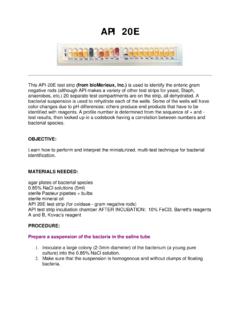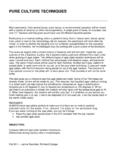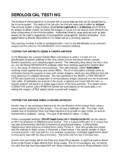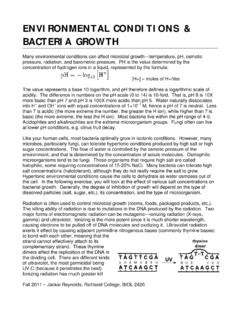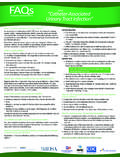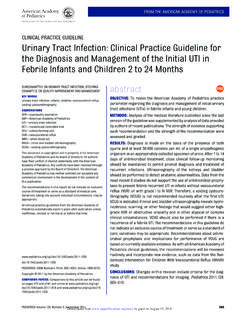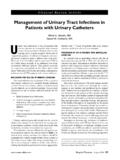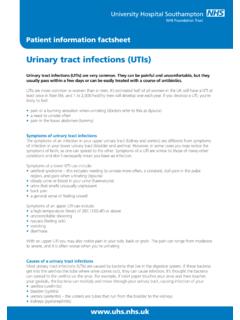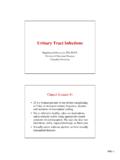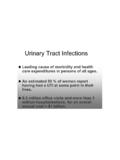Transcription of URINARY TRACT CULTURES
1 URINARY TRACT CULTURES . Assuming that there is no kidney infection (nephritis), urine comes out of the kidney sterile. The sterile urine moves down the ureters into the URINARY bladder for storage. The bladder has a couple of excellent defense mechanisms to keep microbial growth down---a mucin protein layer and IgA from the immune system. There are other defense mechanisms of the URINARY TRACT ---the free flow of urine, antimicrobial chemicals in urine (urea, ammonia), antimicrobial chemicals in semen. Most of the organisms that might produce a bladder infection (cystitis) or urethritis come from the anal area. As the urine moves into the distal urethra, it picks up urethral flora. The bacterial normal flora can include Staphylococcus, Streptococcus, Corynebacterium, Lactobacillus, and members of the family of Enterobacteriaceae, while the fungus Candida (yeast) may also be present.
2 If urine is taken from a healthy person as a catheterized sample or a midstream clean catch, the urine should be essentially free of organisms. The presence of more than 100,000. cells/ml of urine indicates a URINARY TRACT infection (UTI). Less than 10,000 indicates no infection, although a count between 10,000-1000,000/ml does not absolutely rule out an infection. In a sample of voided urine (no precautions about how the sample is taken), upwards of 1000 cells may be contaminants from the urethra. Another key diagnostic test for real infection is the number of white blood cells seen in the microscopic field of vision using a high power (40X) lens. Less than 5 WBC/high power field is normal. In this lab, you will compare a clean catch midstream urine specimen to a normally voided urine specimen. Selectively differential media (CNA and EMB agar) will be used to separate out gram + (Staph, Strep) from gram (Enterobacteriaceae), as well as lactose fermenters (E.)
3 Coli) from nonfermenters (Pseudomonas, Proteus, etc.). Instructions for Clean Catch Midstream Urine Collections You have been given towelettes and a urine specimen cup to obtain a sample of your urine. 1. Unscrew the cap of the urine specimen cup. Place the cap on the counter with the straw facing upward. To avoid contamination, do not touch the inside of the cup, cap or straw. 2. Cleanse yourself with towelettes as follows: Males - Wipe the head (end) of your penis in a single motion with the first towelette. Repeat this with the second towelette. If you are not circumcised, hold the foreskin back before cleansing and continue to hold it back when you are collecting the urine sample. Females - Separate the labia, which are the folds of skin on either side of the area from which you urinate. Wipe the inner folds of skin from front to back in a single motion with the first towelette.
4 Then wipe down through center of labial folds with the second towelette. Make sure to keep the labia separated while you are collecting the urine sample. 3. Urinate a small amount into toilet. 4. Place the collection cup under the stream of urine and continue to urinate into the cup. Once the collection cup is full, finish urinating into toilet. 5. Replace the cap on the cup, and tighten the cap securely. Fall 2011 - Jackie Reynolds, Richland College, BIOL 2420. MATERIALS NEEDED: per table Urine sample (1/100) ml sample calibrated sterile inoculating loops 1 CNA plate 1 EMB plate Antimicrobial towellettes Containers for urine PROCEDURES: 1. Some tables will be designated as midstream clean catch specimens and other tables designated as normal void specimens. 2. Dip the ml loop into the urine same (just into the urine, without submererging the plastic sample. 3. Place a straight line down the center of the agar plate, then streak in a dense zig-zag pattern back and forth across the plate to the bottom.)
5 4. Repeat this previous step for the other agar plate, using a new inoculums. 5. Incubate plates at 37 degrees C. 2nd session: 1. Check your plates for growth. Calculate the number of gram + and gram bacteria in the urine sample by multiplying the colony count X the dilution of the calibrated loop (1/100). If there arehave 50 colonies on the EMB, 50 X 100 dilution = 5000 cells/ml of urine 2. It may be that your count is very sparse and the colony count will be easily determined. However, if the colonies extend more than of the way down the plate, you can guesstimate it at over 100,000 total. 3. Gram stain the predominant colony type on each medium. 4. If there is a predominant coccus on the CNA plate, run a catalase test. Remember that Staph is cat+ while Strep and Enterococcus are cat-. Common microbes: Gram bacilli = probable Enterobacteriaceae family Gram + cocci = probable Staph or Strep Gram + rods = probable Lactobacillus Budding yeast = Candida A GOOD resource for EMB pictures test/2871-eosin-methylene-blue A GOOD resource for blood hemolysis pictures.
6 Streptococcus-and-other-catalase-negativ e-gram-positive-cocci EOSIN METHYLENE BLUE AGAR (EMB). EMB is a selective, differential agar medium used for isolation of gram negative rods in a variety of specimen types. It is used frequently in clinical laboratories. The selective/inhibitory agents of EMB are the dyes eosin Y and methylene blue. Methylene blue inhibits the gram + bacteria (eosin to a lesser extent), while eosin changes color, to a dark purple, when the medium around the colony becomes acidic. EMB contains lactose and sucrose sugars, but it is the lactose that is the key to the medium. Lactose-fermenting bacteria (E. coli and other coliforms) produce acid from lactose use, and the combination of the dyes (which serve as pH indicators in this medium) produces color variations in the colonies because of the acidity. Strong acidity produces a deep purple colony with a green metallic sheen, whereas less acidity may produce a brown-pink coloration of colony.
7 Nonlactose fermenters appear as translucent or pink. Colonies of lactose fermenters will appear very dark purple, or have dark purple centers. Lactose-fermenter (E. coli) nonfermenter plate at left enlarged SOME bacteria gram + bacteria may grow--although not well--particularly if you let CULTURES sit for more than a couple of days. Usually those species will show as pinpoint colonies. COLUMBIA NALADIXIC ACID AGAR (CNA). CNA is a selective, differential agar medium used for isolation of gram positive bacteria in a variety of specimen types. It is used frequently in clinical laboratories. The selective/inhibitory agent of CNA is the antibiotic naladixic acid, a quinolone drug similar to Cipro or This medium is basically blood agar, containing 5% sheep's blood mixed with either TSA base or Columbia agar base. The differentiation of blood agar is due to the ability of many bacteria to hemolyze blood cells, using chemicals called The best way to read hemolysis is to hold the plate up against a light source (sun or lights).
8 There are 3 categories of hemolytic patterns alpha, beta, and gamma. BETA hemolysis is the complete breakdown of RBCs, producing a clear yellow zone (the color of the base media without blood added). ALPHA hemolysis occurs when the hemoglobin within the RBCs is converted to methemoglobin, when released by the lysed RBCs. This produces a brown or green zone (light green to dark green) around the colonies. GAMMA hemolysis indicates the lack of hemolytic ability. NOTE: SOME bacteria gram - bacteria may grow on CNA--although not well--particularly if you let CULTURES sit for more than a couple of days. Usually those species will show as pinpoint colonies. LABORATORY REPORT SHEET: QUESTIONS: 1. What will E. coli colonies appear like on EMB? 2. What is the inhibitory agent in CNA? 3. What is the critical number of cells/ml of urine, over which it is designated to be a UTI?

